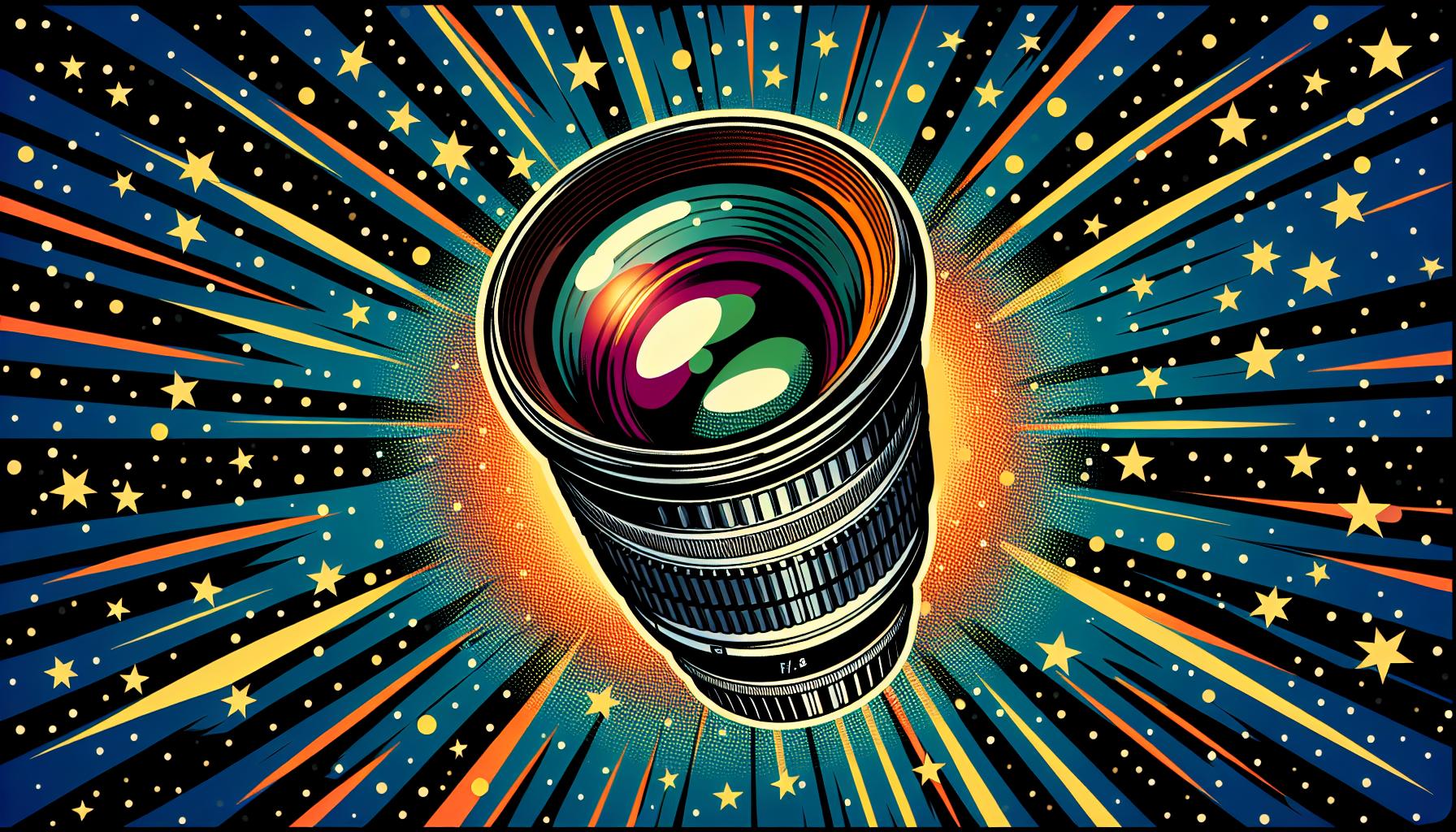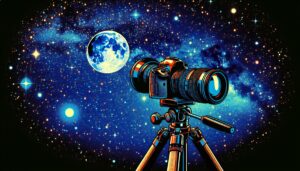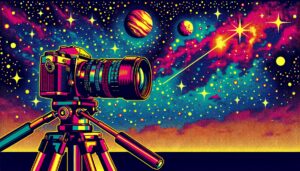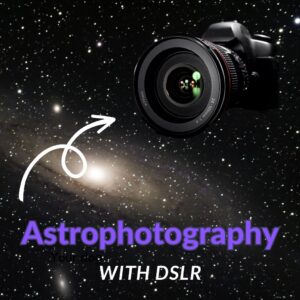This site contains affiliate links to products. I may receive a commission for purchases made through these links.
Astrophotography’s a fascinating field, capturing the beauty of the cosmos right from our backyard. But it’s not just about pointing your camera skywards; the lens you use can make or break your celestial shots.
Choosing the right lens for astrophotography can be a daunting task, especially with so many options out there. But don’t worry, I’m here to guide you through the process.
We’ll explore different types of lenses and their advantages for astrophotography. So whether you’re a newbie stargazer or a seasoned space shooter, you’ll find the perfect lens to make your night sky images truly out of this world.
Types of Lenses for Astrophotography
As we delve deeper into this topic, it’s critical to understand the distinctive types of lenses you can use for your astrophotography. Each brings its unique qualities to the table that can greatly impact your night sky images.
The first type I’d like to highlight are wide-angle lenses. They allow you to capture sweeping vistas of the night sky, making them great for landscape oriented astrophotography. If you’re keen on including a vast expanse of the Milky Way or capturing constellations, these lenses will serve you well.
Then, we have standard or medium lenses. They sit in the middle ground, neither too sweeping nor too close. Use these if you want to capture less sky but more detail in specific objects like planets. They’re kind of a jack-of-all-trades and can significantly sharpen the image, ensuring you capture every star in all its glory.
Finally, consider the telescopic or long lenses. These lenses are like Binoculars, bringing distant objects closer. If your goal is capturing specific celestial bodies, galaxies, or the finer details of the moon, you’ll find these immensely beneficial.
Let’s make it easier with a handy table to visualize the main characteristics of these lens types:
| Lens Type | Best for | Notes |
|---|---|---|
| Wide-angle Lens | Large celestial scenes | Ideal for landscapes |
| Standard/Medium Lens | Specific objects, less sky | Balances field of view and details |
| Telescopic/Long Lens | Capturing distant celestial bodies | Like a telescope |
Wide-angle Lenses for Astrophotography
Moving on to the first type of lens that’s perfect for astrophotography, we land on wide-angle lenses. These types of lenses excel in capturing large areas of the night sky.
What sets wide-angle lenses apart is their wide field of view. They can cover more sky, making them ideal for capturing expansive views of the Milky Way or other sweeping celestial vistas. It’s no surprise that many seasoned sky gazers and astrophotographers lean towards these when they aim to encapsulate the grandeur of the cosmos.
Versatility is another strength of wide-angle lenses. They open intriguing possibilities not only for astrophotography but for landscape photography as well. You’re able to capture a beautiful night sky while also including a broad subjacent landscape. This puts extra context to your shots and builds a stunning harmony between sky and earth.
To the key specifics that are important when choosing a wide-angle lens for astrophotography. This includes aperture, focal length, and the ability to manage chromatic aberrations.
You’d want a lens that offers a wide aperture, typically f/2.8 or wider, to let as much light in as possible. This helps to capture faint stars and galaxies.
Focal length, on the other hand, influences the field of view. A lens with a focal length of around 14-24mm is usually considered ideal for wide-angle astro shots.
Control over chromatic aberrations is crucial, especially when shooting bright star fields. A lens with good aberration control ensures that stars are captured as points of light, not splashes of color.
| Key Specifics | Ideal Values |
|---|---|
| Aperture | f/2.8 or wider |
| Focal length | 14-24mm |
| Aberration control | High |
Remember, astrophotography itself is an experimentation-dependent hobby. The right lens for someone else may not be the right lens for you. Therefore, it’s optimal to try out different wide-angle lenses and see which produces the desired result for your personal style and technique. This type of lens, with its distinctive virtues and potentialities, is indisputably a powerful tool in any stargazer’s arsenal.
Telephoto Lenses for Astrophotography
With all the talk of wide-angle lenses, it’s easy to forget about their larger siblings: telephoto lenses. These magnifying powerhouses have their own set of benefits in the realm of astrophotography. Telephoto lenses, typically with a focal length exceeding 70mm, allow for striking close-up shots of distant celestial bodies.
Let’s go through the distinct advantages telephoto lenses offer.
Achieving Detailed Shots
One of the key advantages of a telephoto lens is its ability to focus on tiny portions of the night sky. It can provide stunning close-ups of, say, the moon’s craters or Jupiter’s stripes. Imagine having a detailed shot of the Orion nebula on your living room wall!
Bigger Isn’t Always Better
While you might think bigger equates to better when it comes to lens size, it’s not always the case with astrophotography. A lens with a larger focal length, say, 600mm, will indeed capture more details but it’s also more difficult to control. You’ll need to adjust exposure times, aperture setting, and will likely need to lug around a heavy and expensive tripod. It also takes more time to set up, track, and process these high-resolution shots.
Finding The Right Balance
Instead, I’d suggest you aim for a telephoto lens with a focal length between 200-400mm. It’s the sweet spot that combines high magnification with ease of use. On top of that, the right aperture should be around f/4 to allow enough light in without compromising the quality of the stars you want to capture. As for chromatic aberration control, it’s just as crucial with a telephoto lens as it is with a wide-angle lens.
In all, remember that photography, including astrophotography, is part art, part science. To that end, experiment with your equipment choices until you find the telephoto lens that best suits your astrophotography needs.
Prime Lenses for Astrophotography
Moving on from telephoto lenses, let’s get into another important type: prime lenses. Often overlooked in the field of astrophotography, prime lenses have their unique strengths. If you’re seeking sharpness and clarity in your shots, prime lenses are a must-try.
Let me tell you, prime lenses have a fixed focal length which isn’t adjustable. That may sound like a drawback but it’s actually one of their strengths. With no need for mechanical parts to transition through focal lengths, prime lenses provide a level of image sharpness that zoom lenses simply can’t match. That’s an essential feature when you’re trying to capture the minute details in celestial bodies like galaxies, star clusters and nebulae.
Astrophotography requires a good amount of patience and exactness. To get usable images of the stars, long exposures are necessary. Prime lenses, with their typically large apertures, often ranging between f/1.2 and f/2.4, can gather more light in a shorter amount of time.
Their wide apertures also mean shallower depths of field. While this doesn’t play a major role in telephoto astrophotography, with prime lenses, it can be used as a creative function, drawing focus to specific celestial elements while creating a silky backdrop of stars.
Here are a few recommended focal lengths and apertures for prime lenses in astrophotography:
| Prime Lenses | Focal Length | Aperture |
|---|---|---|
| Wide-Angle | 24mm | f/1.4 |
| Standard | 50mm | f/1.8 |
| Telephoto | 200mm | f/2.8 |
Zoom Lenses for Astrophotography
While prime lenses offer unbeatable clarity and sharpness, it’s important not to overlook the versatility of zoom lenses in astrophotography. Zoom lenses provide the unique advantage of variable focal lengths. This means you can capture a wide field of stars or narrow down to specific celestial bodies without changing your lens.
Take note: most zoom lenses have variable apertures which differ across the focal length range. It’s important to recognize that the widest aperture may not be available when shooting at the furthest focal length.
One of the attractive benefits of zoom lenses is their flexibility. You have the freedom to adjust focal lengths quickly and easily. This is particularly convenient when the conditions are rapidly changing or you’re scouting to find the most effective composition. As a result, zoom lenses make astrophotography less time-consuming and more user-friendly.
Yet, zoom lenses don’t come without their drawbacks. For one, they generally don’t gather light as efficiently as prime lenses. This can be problematic since astrophotography frequently requires long exposures. Another common issue is that they often produce less sharp and detailed images, especially around the edges.
To achieve the best results, I highly recommend lenses with apertures of f/2.8 or wider. It’s a valuable guide to remember that the faster the lens, the more light it can collect. Particularly impactful in the realm of astrophotography, gaining every possible light photon is crucial to revealing those fascinating details hidden in our vast universe.
Here’s a simple comparison scale between recommended apertures for prime and zoom lenses in astrophotography:
| Lens Type | Recommended Aperture Range |
|---|---|
| Prime | f/1.2 – f/2.4 |
| Zoom | f/2.8 or faster |
Finally, consider the type of astrophotography you’ll be involved with. This will significantly influence the lens choice. Wide field astrophotography generally benefits from wider focal lengths, while deep sky astrophotography requires lenses with longer focal lengths.
Smart selection and use of different types of lenses can enable you to beautifully capture and share the beauty of the night sky.
Conclusion
So there you have it. Choosing the right lens for astrophotography is all about understanding your needs and the trade-offs involved. Zoom lenses bring versatility to the table, with their ability to cover a range of focal lengths. They’re great for capturing both wide fields of stars and zooming in on specific celestial bodies. But remember, they may not be as efficient in gathering light or as sharp as prime lenses.
To get the best out of them, I’d recommend an aperture of f/2.8 or wider. Your choice ultimately depends on what type of astrophotography you’re into, be it wide field or deep sky. With the right lens, you’ll be well on your way to capturing the cosmos in all its glory.




